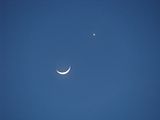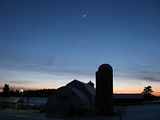I had my ATV loaded up and ready to go to the Castle Rock Family ATV Club's annual meeting. I put the last things in the truck. I came in the house, hollered "GOODBYE" because Mrs. was mopping the bathroom floor. She came out of the bathroom and said "come here, I want to show you something". I said I didn't have time to mess around, I had to get going to make it to the meeting, almost an hour's drive. She said this couldn't wait and I had to see it before I left.
Great. While she was mopping, she managed to break the water pipe off the bottom of the toilet! What the hell was she using for a mop, my splitting maul? There was water running all over the floor.
This sort of thing happens all the time when I want to go ride my ATV. I don't go all that often, it's not like I go everyday or even every week, so I think it's more than mere coincidence. A curse maybe?
That ended my plans AGAIN. Laying on the wet floor under a leaking toilet is way more fun than spending the day with my friends and riding my ATV. Right? WRONG!
- Quads, hailing from Grand Marsh Observatory atop Elk Castle Hill
Saturday, February 28, 2009
Cast Your Vote to Name Space Station's New Room
NASA wants your help in naming a new space station module that boasts a room with a view.
Individuals can vote to name the International Space Station's new Node 3 module via an online ballot, choosing from one of four NASA suggestions such as Earthrise, Legacy, Serenity or Venture. Creative types may also write in a name, although such an entrant would likely represent a dark horse in the race. The Node 3 name polls close on March 20.
Node 3 includes a cupola — essentially an observation deck attached to module — which offers astronauts unparalleled sights of both Earth and space. The cupola's six windows also provide excellent working views for anyone manning the robotics work station that controls the International Space Station's 57-foot robotic arm.
The new station room is slated to launch toward the space station aboard a NASA shuttle in late 2009.
Node 3's main body contains eight refrigerator-sized racks meant to provide room for many of the station's life support systems. After installation, the crew would transfer over many systems to the module, such as those responsible for oxygen generation and water recovery. The astronaut washroom would also likely find a home in the new space station room.
NASA's call for Node 3 names is only the second time the agency has solicited outside help in naming a piece of U.S. space station hardware. People in search of inspiration can always look to past module names, unless they want to go above and beyond the 2,200 students who participated in NASA's Node 2 Challenge.
"The name should reflect the spirit of exploration and cooperation embodied by the space station and follow in the tradition set by Node 1, named 'Unity,' and Node 2, named 'Harmony,'" says NASA's Web site.
A winning name will be announced at the Node 3 unveiling April 28 at NASA's Kennedy Space Center in Florida.
Even people whose favorite Node 3 name loses out can look forward to more spectacular astronaut photography from the new vantage point inside the cupola. Or they might consider stepping into the role of a robotic arm operator in NASA's upcoming online multiplayer game.
Click here to cast your vote at NASA's Node 3 Web site through March 20.
source....
Individuals can vote to name the International Space Station's new Node 3 module via an online ballot, choosing from one of four NASA suggestions such as Earthrise, Legacy, Serenity or Venture. Creative types may also write in a name, although such an entrant would likely represent a dark horse in the race. The Node 3 name polls close on March 20.
Node 3 includes a cupola — essentially an observation deck attached to module — which offers astronauts unparalleled sights of both Earth and space. The cupola's six windows also provide excellent working views for anyone manning the robotics work station that controls the International Space Station's 57-foot robotic arm.
The new station room is slated to launch toward the space station aboard a NASA shuttle in late 2009.
Node 3's main body contains eight refrigerator-sized racks meant to provide room for many of the station's life support systems. After installation, the crew would transfer over many systems to the module, such as those responsible for oxygen generation and water recovery. The astronaut washroom would also likely find a home in the new space station room.
NASA's call for Node 3 names is only the second time the agency has solicited outside help in naming a piece of U.S. space station hardware. People in search of inspiration can always look to past module names, unless they want to go above and beyond the 2,200 students who participated in NASA's Node 2 Challenge.
"The name should reflect the spirit of exploration and cooperation embodied by the space station and follow in the tradition set by Node 1, named 'Unity,' and Node 2, named 'Harmony,'" says NASA's Web site.
A winning name will be announced at the Node 3 unveiling April 28 at NASA's Kennedy Space Center in Florida.
Even people whose favorite Node 3 name loses out can look forward to more spectacular astronaut photography from the new vantage point inside the cupola. Or they might consider stepping into the role of a robotic arm operator in NASA's upcoming online multiplayer game.
Click here to cast your vote at NASA's Node 3 Web site through March 20.
source....
The Necedah Memorial Library has closed its doors.
Library Director, Jim Eliason, has sounded the alarm and as directed by the Library Board....the Necedah Memorial Library will be closed until further notice. Eliason says the building is structurally unsound. It has been an on-going problem...but with the recent thaw....the foundation in the southeast corner of the building has moved...affecting the safety of library patrons. The almost 100-year old building is owned by the Necedah Memorial Library Foundation and a representative of the foundation has been alerted to the safety issue.
Staff will be at the library from 11am until 1pm Monday, Tuesday, Wednesday, Friday, and Saturday to accept returned items only. If patrons wish to request items, they will be sent to other area libraries for pick-up.
source....
Staff will be at the library from 11am until 1pm Monday, Tuesday, Wednesday, Friday, and Saturday to accept returned items only. If patrons wish to request items, they will be sent to other area libraries for pick-up.
source....
Friday, February 27, 2009
The Moon and Venus
The Moon slips past the planet Venus this evening.
Venus is the brilliant "evening star." They are well up in the west as night falls, with Venus just to the right or lower right of the Moon. They set around 9 or 9:30 p.m.
- Quads, hailing from Grand Marsh Observatory atop Elk Castle Hill
- Quads, hailing from Grand Marsh Observatory atop Elk Castle Hill
Is this Atlantis?

THIS is the amazing image which could show the fabled sunken city of Atlantis.
It shows a perfect rectangle the size of Wales lying on the bed of the Atlantic Ocean nearly 3½ miles down.
A host of criss-crossing lines, looking like a map of a vast metropolis, are enclosed by the boundary.
They seem too vast and organised to be caused naturally.
And last night the possibility of an extraordinary discovery had oceanographers and geophysicists captivated.
The site lies 620 miles off the west coast of Africa near the Canary Islands — a location for Atlantis seemingly suggested by the ancient philosopher Plato.
He believed it was an island civilisation sunk by an earthquake and floods around 9,700BC — nearly 12,000 years ago.
The “grid” showed up on Google Ocean, a Google Earth extension that uses a combination of satellite images and marine surveys.
Last night Dr Charles Orser, curator of historical archaeology at New York State University — and one of the world’s leading authorities on Atlantis — called it “fascinating”.
He said: “The site is one of the most prominent places for the proposed location of Atlantis, as described by Plato. Even if it turns out to be geographical, this definitely deserves a closer look.”
The legend of Atlantis has captured the imagination of scholars for centuries.
And in the 1970s it spawned a hit TV series, Man From Atlantis, in which Patrick Duffy played a webbed hero who could live underwater.
Situated in an area called the Madeira Abyssal Plane, the grid was spotted by aeronautical engineer Bernie Bamford as he browsed through Google Ocean.
Bernie, 38, of Chester, said: “It looks like an aerial map of Milton Keynes. It must be man-made.”
source....
Thursday, February 26, 2009
Largest US camera store seeks bankruptcy protection
Ritz Camera, the largest dedicated camera retailer in the US has filed for Chapter 11 bankruptcy protection. The company, which owns over 800 stores across the country, under a series of names, including Wolf Camera, has proposed a restructuring plan that will aim to see the chain continue in some form. As part of this, the company has applied to the bankruptcy court for permission to continue to honor its customer loyalty and rebate schemes.
In an affidavit to the court Marc Weinsweig, appointed as Chief Restructuring Officer and COO as part of the Chapter 11 process, describes his actions as being aimed at 'maintaining the day-to-day operations of the company's business with minimal disruption' in what he characterizes as 'daunting economic times.'
Court papers suggest that Ritz Cameras owes over $40 million to its two largest creditors: Nikon's US subsidiary Nikon Inc. and Canon USA, with a further $8.4 million owed to Fujifilm USA, a subsidiary of which owns around a third of the company. To put the $26.6 million owed to Nikon Inc. into perspective, it would represent somewhere in the region of 20% of Nikon Inc's expected annual operating income.
Chapter 11 of the US Bankruptcy Code provides companies with protection from their creditors while they attempt to restructure. However, US retailer Circuit City, which filed for bankruptcy protection in November 2008 announced the closure of all its stores and the liquidation of its assets on January 16th.
source....
In an affidavit to the court Marc Weinsweig, appointed as Chief Restructuring Officer and COO as part of the Chapter 11 process, describes his actions as being aimed at 'maintaining the day-to-day operations of the company's business with minimal disruption' in what he characterizes as 'daunting economic times.'
Court papers suggest that Ritz Cameras owes over $40 million to its two largest creditors: Nikon's US subsidiary Nikon Inc. and Canon USA, with a further $8.4 million owed to Fujifilm USA, a subsidiary of which owns around a third of the company. To put the $26.6 million owed to Nikon Inc. into perspective, it would represent somewhere in the region of 20% of Nikon Inc's expected annual operating income.
Chapter 11 of the US Bankruptcy Code provides companies with protection from their creditors while they attempt to restructure. However, US retailer Circuit City, which filed for bankruptcy protection in November 2008 announced the closure of all its stores and the liquidation of its assets on January 16th.
source....
The CIA estimates that almost half of the UFOs reported in the 1950s and 1960s were not American spy planes.
Spy and stealth planes—some with bizarre, bat-shaped wings, others with triangular silhouettes that imply otherworldly designs—have long generated UFO sightings and lore. And official denials feed rumors that the government isn’t telling us about alien ships. The CIA estimates that almost half of the UFOs reported from the ’50s through the ’60s were not U-2 or SR-71 spy planes. At the time, the Air Force misled the public and the media to protect these Cold War programs; it’s possible the government’s responses to current sightings of classified craft—whether manned or remotely operated—are equally evasive. The result is an ongoing source of UFO reports and conspiracy theories.
source....
Thanks for the link Rich!
- Quads, hailing from Grand Marsh Observatory atop Elk Castle Hill
source....
Thanks for the link Rich!
- Quads, hailing from Grand Marsh Observatory atop Elk Castle Hill
Wednesday, February 25, 2009
Black River State Forest Conditions
Conditions as of Wednesday, February 25, 2009:
Up to 6 inches of snow is predicted for Thursday at Black River Falls. If this happens, trails will be open, freshly groomed, and in good shape for winter recreation. Temperatures are expected to remain below freezing from Thursday through Tuesday of next week and then begin to warm. This may be the last hurrah for winter enthusiasts!
source....
Up to 6 inches of snow is predicted for Thursday at Black River Falls. If this happens, trails will be open, freshly groomed, and in good shape for winter recreation. Temperatures are expected to remain below freezing from Thursday through Tuesday of next week and then begin to warm. This may be the last hurrah for winter enthusiasts!
source....
Firewood and Calves
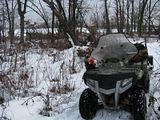
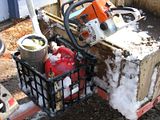
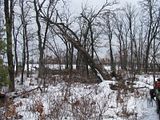
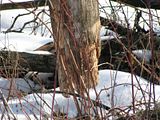

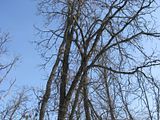
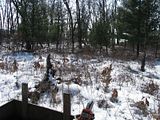

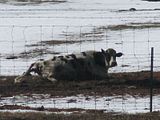
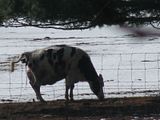
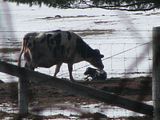
- Quads, hailing from Grand Marsh Observatory atop Elk Castle Hill
News From The Observatory
The brightest star in our night sky is Sirius, the dog star. It is low in the south right now. If you live in the southern United States, you can see one of the few stars to rival Sirius: Canopus, the second-brightest star in the night sky. It is well to the south of Sirius.
- Quads, hailing from Grand Marsh Observatory atop Elk Castle Hill
- Quads, hailing from Grand Marsh Observatory atop Elk Castle Hill
Tuesday, February 24, 2009
Launch Mishap Ends OCO Mission
NASA's Orbiting Carbon Observatory satellite failed to reach orbit after its 4:55 a.m. EST liftoff Feb. 24 from California's Vandenberg Air Force Base.
Preliminary indications are that the fairing on the Taurus XL launch vehicle failed to separate. The fairing is a clamshell structure that encapsulates the satellite as it travels through the atmosphere.
The spacecraft did not reach orbit and likely landed in the ocean near Antarctica, said John Brunschwyler, the program manager for the Taurus XL.
A Mishap Investigation Board is to determine the cause of the launch failure.
source....
Preliminary indications are that the fairing on the Taurus XL launch vehicle failed to separate. The fairing is a clamshell structure that encapsulates the satellite as it travels through the atmosphere.
The spacecraft did not reach orbit and likely landed in the ocean near Antarctica, said John Brunschwyler, the program manager for the Taurus XL.
A Mishap Investigation Board is to determine the cause of the launch failure.
source....
FAA: Falling Metal Did Not Come From Airplane
The Federal Aviation Administration says a piece of hot metal that crashed through the roof of a Jersey City business did not come from an airplane.
FAA spokeswoman Arlene Salac says investigators examined the metal and determined it is made of cast iron, which is not used in airplanes. She says it's up to local authorities to determine where the object came from.
Owner Al Smith was fork-lifting a sofa onto a wooden storage platform around 10 a.m. at his moving company when he heard a sound he thought was a bomb.
A piece of warm metal the size of a brick came crashing through the roof just steps from where he was standing. It splintered a wooden beam and crashed into a shelf.
Smith tells WCBS radio that no one was injured. He plans buy a lottery ticket, saying it's his lucky day.
He says the metal is about the size of a brick and came crashing through the roof around 10 a.m.
Officials at the scene also confirmed to WCBS radio that the metal was too hot to touch for about 30 minutes after crashing through the roof.
source....
The Federal Aviation Administration says a piece of hot metal that crashed through the roof of a Jersey City business did not come from an airplane.
FAA spokeswoman Arlene Salac says investigators examined the metal and determined it is made of cast iron, which is not used in airplanes. She says it's up to local authorities to determine where the object came from.
Owner Al Smith was fork-lifting a sofa onto a wooden storage platform around 10 a.m. at his moving company when he heard a sound he thought was a bomb.
A piece of warm metal the size of a brick came crashing through the roof just steps from where he was standing. It splintered a wooden beam and crashed into a shelf.
Smith tells WCBS radio that no one was injured. He plans buy a lottery ticket, saying it's his lucky day.
He says the metal is about the size of a brick and came crashing through the roof around 10 a.m.
Officials at the scene also confirmed to WCBS radio that the metal was too hot to touch for about 30 minutes after crashing through the roof.
source....
Monday, February 23, 2009
Leo, the lion, climbs the eastern sky this evening. It is in full view by about 8 p.m. Its brightest star, Regulus, is high in the sky by then, well above the golden planet Saturn. And the lion's tail, represented by the star Denebola, is a little to the left of Saturn.
- Quads, hailing from Grand Marsh Observatory atop Elk Castle Hill
- Quads, hailing from Grand Marsh Observatory atop Elk Castle Hill
TITAN TRANSIT
Saturn's rings are nearly edge-on to Earth and this is giving astronomers a chance to see unaccustomed things. One of them--a transit of Titan.
Titan passes in front of Saturn fairly often, but the transits are usually hidden from view by Saturn's broad rings. Only when the rings are edge-on does the giant moon's silhouette reveal itself to backyard telescopes.
There will be two more transits visible this year: Feb 24th and March 12th. The one on Feb 24th is special as it will be a quadruple transit of Titan, Mimas, Dione and Enceladus. At around 14:25UT on that day, all four moons will be within Saturn's disk.
Feb 24th is special for another reason: Comet Lulin makes its closest approach to Earth on that date, coincidentally just a few degrees away from Saturn. In one quick sweep of a backyard telescope, you'll be able to see Titan, Saturn's edge-on rings, and a green comet with an active tail.

- Quads, hailing from Grand Marsh Observatory atop Elk Castle Hill
Saturn's rings are nearly edge-on to Earth and this is giving astronomers a chance to see unaccustomed things. One of them--a transit of Titan.
Titan passes in front of Saturn fairly often, but the transits are usually hidden from view by Saturn's broad rings. Only when the rings are edge-on does the giant moon's silhouette reveal itself to backyard telescopes.
There will be two more transits visible this year: Feb 24th and March 12th. The one on Feb 24th is special as it will be a quadruple transit of Titan, Mimas, Dione and Enceladus. At around 14:25UT on that day, all four moons will be within Saturn's disk.
Feb 24th is special for another reason: Comet Lulin makes its closest approach to Earth on that date, coincidentally just a few degrees away from Saturn. In one quick sweep of a backyard telescope, you'll be able to see Titan, Saturn's edge-on rings, and a green comet with an active tail.

- Quads, hailing from Grand Marsh Observatory atop Elk Castle Hill
Sunday, February 22, 2009
What did I do today? You guessed it!
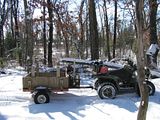

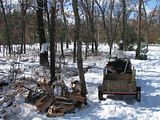
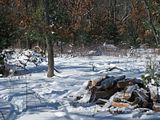


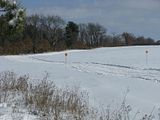
- Quads, hailing from Grand Marsh Observatory atop Elk Castle Hill
Arizona: UFO over Tucson spotted
A number of witnesses have come forward to describe remarkable sighting of a UFO in the vicinity of the city of Tucson, Arizona. The UFO is being described as classic saucer shaped with red glowing lights. The craft was spotted on the evening of 11 February 2009.
One witness was sitting and watching television with her husband, a former Airman, and her daughter when she noticed a UFO through a large glass sliding door that looks out towards the Tucson Mountains behind her backyard.
The witness described the object as disc shaped with non-strobing red lights at its front and rear. She estimated it was moving south to north at an altitude of about 150m. The object then ‘exploded’ in a large blaze of bright white light and sped away horizontal to the earth at an incredible speed.
At this point she alerted her husband. Soon afterwards helicopters were seen moving in the direction of the craft. The witness’s husband, who had served in the Air Force, thought the helicopters might have been Blackhawks.
Another witness was driving a truck just outside of Tucson when he saw pretty much the same thing. He described the explosion and subsequent fantastic speed as ‘unbelievable, probably alien’. Local police also noted that a few calls had been taken regarding the incident.
Many are wondering whether the military is testing secret aircraft in Arizona or do aliens simply enjoy its wide open spaces. At least one of the witnesses seems to think the latter.
source....
A number of witnesses have come forward to describe remarkable sighting of a UFO in the vicinity of the city of Tucson, Arizona. The UFO is being described as classic saucer shaped with red glowing lights. The craft was spotted on the evening of 11 February 2009.
One witness was sitting and watching television with her husband, a former Airman, and her daughter when she noticed a UFO through a large glass sliding door that looks out towards the Tucson Mountains behind her backyard.
The witness described the object as disc shaped with non-strobing red lights at its front and rear. She estimated it was moving south to north at an altitude of about 150m. The object then ‘exploded’ in a large blaze of bright white light and sped away horizontal to the earth at an incredible speed.
At this point she alerted her husband. Soon afterwards helicopters were seen moving in the direction of the craft. The witness’s husband, who had served in the Air Force, thought the helicopters might have been Blackhawks.
Another witness was driving a truck just outside of Tucson when he saw pretty much the same thing. He described the explosion and subsequent fantastic speed as ‘unbelievable, probably alien’. Local police also noted that a few calls had been taken regarding the incident.
Many are wondering whether the military is testing secret aircraft in Arizona or do aliens simply enjoy its wide open spaces. At least one of the witnesses seems to think the latter.
source....
Saturday, February 21, 2009
5 Inches Of Fresh Snow
I thought it was done snowing, so plowed the driveway and then went out and cut more firewood. Turns out it wasn't done snowing and I cut firewood all day in a snowstorm! No big deal. Hardly even noticed.
I didn't take the camera out with me today. Too wet and nasty. I did take the scanner. I keep it in a Ziploc freezer bag when the weather is bad. Works great. (In case you're wondering, sound travels through a freezer bag like it isn't even there.)
I got a nice bunch of wood cut and split again. One tree was a gnarly, twisted monster. Takes more than that to scare me into getting a splitting machine though. I love a splitting challenge. It took a lot of very powerful swings of the maul, all the way up, to finish this tree. Just what I like. Piece of cake.
- Quads, hailing from Grand Marsh Observatory atop Elk Castle Hill
I didn't take the camera out with me today. Too wet and nasty. I did take the scanner. I keep it in a Ziploc freezer bag when the weather is bad. Works great. (In case you're wondering, sound travels through a freezer bag like it isn't even there.)
I got a nice bunch of wood cut and split again. One tree was a gnarly, twisted monster. Takes more than that to scare me into getting a splitting machine though. I love a splitting challenge. It took a lot of very powerful swings of the maul, all the way up, to finish this tree. Just what I like. Piece of cake.
- Quads, hailing from Grand Marsh Observatory atop Elk Castle Hill
Brilliant Orion stands proudly in the south this evening. A big rectangle of bright stars outlines his body, while a short line of three stars in the middle represents his belt. Two supergiants stand at opposite corners of the rectangle: orange Betelgeuse at the upper left, and blue-white Rigel at the lower right.
- Quads, hailing from Grand Marsh Observatory atop Elk Castle Hill
- Quads, hailing from Grand Marsh Observatory atop Elk Castle Hill
The sky is falling? Reports of falling debris a mystery in Texas
Law enforcement agencies across Texas received numerous reports Sunday of a fireball and falling debris.
John Foster, a spokesman for the Williamson County Sheriff’s Office in Georgetown, said deputies and firefighters were out looking for debris after callers said they thought they saw a plane crashing. Foster said the department took its helicopter up to search for the source of the debris, but found nothing.
“We don’t doubt what people saw” but they found no debris, he said.
The Federal Aviation Administration said it received numerous reports across Texas of falling debris.
“We don’t know what it was,” said FAA spokesman Roland Herwig.
The U.S. Strategic Command said there was no connection to the sightings over Texas and Tuesday’s collision of satellites from the U.S. and Russia.
“There is no correlation between the debris from that collision and those reports of re-entry,” said Maj. Regina Winchester, with STRATCOM.
The FAA notified pilots on Saturday to be aware of possible space debris after a collision Tuesday between U.S. and Russian communication satellites. The chief of Russia’s Mission Control says clouds of debris from the collision will circle Earth for thousands of years and threaten numerous satellites.
source....
Law enforcement agencies across Texas received numerous reports Sunday of a fireball and falling debris.
John Foster, a spokesman for the Williamson County Sheriff’s Office in Georgetown, said deputies and firefighters were out looking for debris after callers said they thought they saw a plane crashing. Foster said the department took its helicopter up to search for the source of the debris, but found nothing.
“We don’t doubt what people saw” but they found no debris, he said.
The Federal Aviation Administration said it received numerous reports across Texas of falling debris.
“We don’t know what it was,” said FAA spokesman Roland Herwig.
The U.S. Strategic Command said there was no connection to the sightings over Texas and Tuesday’s collision of satellites from the U.S. and Russia.
“There is no correlation between the debris from that collision and those reports of re-entry,” said Maj. Regina Winchester, with STRATCOM.
The FAA notified pilots on Saturday to be aware of possible space debris after a collision Tuesday between U.S. and Russian communication satellites. The chief of Russia’s Mission Control says clouds of debris from the collision will circle Earth for thousands of years and threaten numerous satellites.
source....
Friday, February 20, 2009
Cutting Firewood Again Today



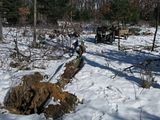
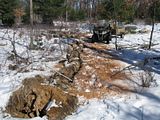

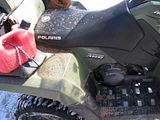
- Quads, hailing from Grand Marsh Observatory atop Elk Castle Hill
AURORA WATCH
Sky watchers should be alert for Northern Lights tonight. A solar wind stream is heading for Earth, and NOAA forecasters estimate a 30% chance of high-latitude geomagnetic activity when it arrives sometime during the next 24 hours.
- Quads, hailing from Grand Marsh Observatory atop Elk Castle Hill
- Quads, hailing from Grand Marsh Observatory atop Elk Castle Hill
Galaxy has 'billions of Earths'
There could be one hundred billion Earth-like planets in our galaxy, a US conference has heard.
Dr Alan Boss of the Carnegie Institution of Science said many of these worlds could be inhabited by simple lifeforms.
He was speaking at the annual meeting of the American Association for the Advancement of Science in Chicago.
So far, telescopes have been able to detect just over 300 planets outside our Solar System.
Very few of these would be capable of supporting life, however. Most are gas giants like our Jupiter, and many orbit so close to their parent stars that any microbes would have to survive roasting temperatures.
But, based on the limited numbers of planets found so far, Dr Boss has estimated that each Sun-like star has on average one "Earth-like" planet.
This simple calculation means there would be huge numbers capable of supporting life.
"Not only are they probably habitable but they probably are also going to be inhabited," Dr Boss told BBC News. "But I think that most likely the nearby 'Earths' are going to be inhabited with things which are perhaps more common to what Earth was like three or four billion years ago." That means bacterial lifeforms.
Dr Boss estimates that Nasa's Kepler mission, due for launch in March, should begin finding some of these Earth-like planets within the next few years.
Recent work at Edinburgh University tried to quantify how many intelligent civilisations might be out there. The research suggested there could be thousands of them.
source....
There could be one hundred billion Earth-like planets in our galaxy, a US conference has heard.
Dr Alan Boss of the Carnegie Institution of Science said many of these worlds could be inhabited by simple lifeforms.
He was speaking at the annual meeting of the American Association for the Advancement of Science in Chicago.
So far, telescopes have been able to detect just over 300 planets outside our Solar System.
Very few of these would be capable of supporting life, however. Most are gas giants like our Jupiter, and many orbit so close to their parent stars that any microbes would have to survive roasting temperatures.
But, based on the limited numbers of planets found so far, Dr Boss has estimated that each Sun-like star has on average one "Earth-like" planet.
This simple calculation means there would be huge numbers capable of supporting life.
"Not only are they probably habitable but they probably are also going to be inhabited," Dr Boss told BBC News. "But I think that most likely the nearby 'Earths' are going to be inhabited with things which are perhaps more common to what Earth was like three or four billion years ago." That means bacterial lifeforms.
Dr Boss estimates that Nasa's Kepler mission, due for launch in March, should begin finding some of these Earth-like planets within the next few years.
Recent work at Edinburgh University tried to quantify how many intelligent civilisations might be out there. The research suggested there could be thousands of them.
source....
Thursday, February 19, 2009
Wichita UFO report draws wide attention
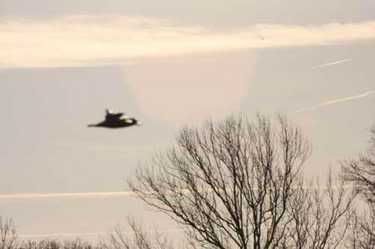
It flew fast like a jet, made a whirling sound and left an odd glow.
That's how an amateur photographer described a flying machine he spotted in the skies near Rose Hill on Friday. The UFO world is now paying attention to his photograph.
On Monday, the photo appeared under the headline "Weird Object in Wichita," on UFO Digest, a Canadian Web site.
The object looks like some kind of new-technology fighter jet, possibly a prototype, said UFO Digest editor and publisher Dirk Vander Ploeg.
Jarrod Bartlett, spokesman for Boeing Integrated Defense Systems-Wichita, said in an e-mail that he checked with flight operations staff "and they were not able to identify the aircraft. We do not often get calls regarding unidentified aircraft."
McConnell Air Force Base declined to comment.
The man who captured the image said he took the photo at 8:42 a.m. Friday near 210th and Prairie Creek Road, about three miles south of Rose Hill.
"I was facing east when I shot the photo," the man, who asked not to be identified, said in an e-mail.
He described what he saw: "The object came out of the clouds really fast. It sounded kind of like a jet but much, much softer and had a whirling sound with it.
"I only got off one shot because it was really close before I realized it was something different. It went back upward, much like a jet, and was gone.
"There was a odd pinkish glow in the sky behind it."
In a telephone interview, the man said he takes still-life photos as a hobby. He said it was fortunate he had his camera out when the object flew into his view because he saw it for only a few seconds.
"The only problem was I had a real slow lens... . I wasn't planning on taking a picture of anything moving," he said.
He said he used to work at Boeing and has seen a lot of aircraft over the years.
"It didn't sound like one of these jets that I hear all the time.... It was much quieter, much quieter," he said.
He noticed that the flying machine's exterior looked black and shiny.
He estimated the object came no closer than 1,000 feet above the ground. It swooped in as if it was on "a bombing run."
"Then in one smooth motion, it went back up," he said.
After he took the photo, relatives urged him to send it to the UFO publication. He was reluctant.
"I didn't want people to think I'm nuts," he said.
Vander Ploeg, the UFO Digest publisher, said he is a former small-plane pilot who is familiar with various aircraft. He said he was confident that the image is not a hoax.
"But I can't tell you what it is," he said.
"I've never seen a plane that looks like that."
source....

It flew fast like a jet, made a whirling sound and left an odd glow.
That's how an amateur photographer described a flying machine he spotted in the skies near Rose Hill on Friday. The UFO world is now paying attention to his photograph.
On Monday, the photo appeared under the headline "Weird Object in Wichita," on UFO Digest, a Canadian Web site.
The object looks like some kind of new-technology fighter jet, possibly a prototype, said UFO Digest editor and publisher Dirk Vander Ploeg.
Jarrod Bartlett, spokesman for Boeing Integrated Defense Systems-Wichita, said in an e-mail that he checked with flight operations staff "and they were not able to identify the aircraft. We do not often get calls regarding unidentified aircraft."
McConnell Air Force Base declined to comment.
The man who captured the image said he took the photo at 8:42 a.m. Friday near 210th and Prairie Creek Road, about three miles south of Rose Hill.
"I was facing east when I shot the photo," the man, who asked not to be identified, said in an e-mail.
He described what he saw: "The object came out of the clouds really fast. It sounded kind of like a jet but much, much softer and had a whirling sound with it.
"I only got off one shot because it was really close before I realized it was something different. It went back upward, much like a jet, and was gone.
"There was a odd pinkish glow in the sky behind it."
In a telephone interview, the man said he takes still-life photos as a hobby. He said it was fortunate he had his camera out when the object flew into his view because he saw it for only a few seconds.
"The only problem was I had a real slow lens... . I wasn't planning on taking a picture of anything moving," he said.
He said he used to work at Boeing and has seen a lot of aircraft over the years.
"It didn't sound like one of these jets that I hear all the time.... It was much quieter, much quieter," he said.
He noticed that the flying machine's exterior looked black and shiny.
He estimated the object came no closer than 1,000 feet above the ground. It swooped in as if it was on "a bombing run."
"Then in one smooth motion, it went back up," he said.
After he took the photo, relatives urged him to send it to the UFO publication. He was reluctant.
"I didn't want people to think I'm nuts," he said.
Vander Ploeg, the UFO Digest publisher, said he is a former small-plane pilot who is familiar with various aircraft. He said he was confident that the image is not a hoax.
"But I can't tell you what it is," he said.
"I've never seen a plane that looks like that."
source....
Wednesday, February 18, 2009
Crab Nebula
This odd-looking nebula is the remnant of a supernova that lit the skies in 1054 and was recorded by Chinese and Arab astronomers. A modest smudge in a small telescope, the beauty of this object lies in the imagination… you are seeing the remnant of the most massive explosions in the galaxy, a supernova that seeded the interstellar medium with heavy elements, some of which will find their way into new stars and planets over the coming billions of years. Find the Crab Nebula (or Messier 1) just off the prominent star zeta Tauri (see below).

source....
This odd-looking nebula is the remnant of a supernova that lit the skies in 1054 and was recorded by Chinese and Arab astronomers. A modest smudge in a small telescope, the beauty of this object lies in the imagination… you are seeing the remnant of the most massive explosions in the galaxy, a supernova that seeded the interstellar medium with heavy elements, some of which will find their way into new stars and planets over the coming billions of years. Find the Crab Nebula (or Messier 1) just off the prominent star zeta Tauri (see below).

source....
Tuesday, February 17, 2009
Spot 5 Planets
This month you'll have an opportunity to see all five naked-eye planets – but not all at once. Two of them are evening objects, while the other three are clustered together low in the east-southeast sky deep in the dawn twilight.
The planets move around in our sky and become brighter and dimmer over time depending on where they are in their orbits around the sun. Uranus, Neptune and Pluto are never visible to the naked eye.
Here's what you can look for:
The Evening Lantern
If you ever wanted to see a planet so bright it will take your breath away, this is your week and Venus is the planet. It hangs lantern-like, high in the west as darkness falls. It's so bright now that you should have little trouble finding it even before sunset in a clean, deep blue sky – which is also a good time to look at its dramatic crescent shape in a telescope.
As dusk starts to fade, this unrivaled heavenly lamp can scarcely be missed â€" you won't need a map. Venus sets more than 3 hours after the sun.
Venus is now at the pinnacle of brilliancy for this current evening apparition. Viewed through a telescope in the coming weeks, its crescent grows larger but thinner as the planet approaches the Earth in the celestial scheme of things and shows us more of its night side. By month's end Venus is similar in apparent size to Jupiter – but less than one-quarter of it is lit.
Gray markings in the planet's cloud cover remain quite subtle. Look around sunset, when the sky is brighter and Venus's crescent is less dazzling than it becomes after dark. Also, watch for signs of the mysterious ashen light – a still unexplained illumination that some observers have occasionally noticed in parts of Venus's night side.
On the evening of Feb. 27 the Americas will be greeted with one of the most spectacular Venus-crescent moon conjunctions possible. The pairing will persist from before sunset into the depths of darkness. Venus will sit about 1.5-degrees above and to the right of the three-day old crescent. Be sure not to miss this!
Lord of the Rings
The next planet to look for is Saturn. This week it comes up above the eastern horizon about 90 minutes after sunset, but by the time of its opposition to the sun on March 8 it will be visible all night from dusk to dawn. Two nights later, on March 10, Saturn will ride high above the full moon.
Brightening slightly from magnitude +0.7 to +0.5, Saturn appears twice as bright as the bluish star, Regulus, the brightest star of Leo, the Lion. Shining sedately with a yellow-white hue, Saturn appears far to the lower left of that first magnitude star during the evening.
If you have a telescope magnifying at least 30-power, you'll be able to glimpse the famous ring system, which now looks like a bright line that bisects Saturn's disk. The rings open slightly to 2.3-degrees from edgewise by the end of February, but the rings will start closing again later this spring, ultimately disappearing even in big telescopes by midsummer.
A planetary trio
The other three planets visible are morning objects. Two of these are visible toward month's end but with some difficulty: Jupiter and Mercury.
Solar conjunction for Jupiter was on Jan. 24; by the final week of February it'll be on its way back into view, appearing a little higher each day. Off to its upper right will be fainter Mercury. Bring binoculars for this challenging sighting; the two planets will be very low above the east-southeastern horizon about 30-35 minutes before sunrise.
Just before sunrise on the 22nd, seek out the slender sliver of an old crescent moon, just 2-½ days before new phase, low near the east-southeast horizon. If you find it, use it as your guide to locate Mercury and Jupiter, located about 5 or 6-degrees to the moon's lower left. Binoculars will help.
Jupiter and Mercury engage in a close conjunction early on the morning of Feb. 24, with Jupiter appearing to stand almost directly above Mercury; they're separated by 0.7-degree. For comparison, the moon's apparent width is 0.5-degree. The place to look is very low in the east-southeast. Mercury shines at a respectable magnitude -0.1, but still appears only about one-sixth as bright as Jupiter's -2.0.
The only planet seemingly out of the loop in terms of visibility is Mars. Shining at magnitude +1.3 and rising deep in the glow of dawn less than an hour before sunup, it's not yet a naked-eye object for mid-northerners. Nonetheless, on the mornings of Feb. 16, 17 and 18, Mars and Jupiter will be separated by less than 1-degree. On the 17th, in fact, Jupiter will appear just 0.6-degree to the upper left of Mars. So if you can locate Jupiter, you should be able to find Mars with binoculars or a small telescope.
And with Mercury close by this makes for a planetary trio.
source....
This month you'll have an opportunity to see all five naked-eye planets – but not all at once. Two of them are evening objects, while the other three are clustered together low in the east-southeast sky deep in the dawn twilight.
The planets move around in our sky and become brighter and dimmer over time depending on where they are in their orbits around the sun. Uranus, Neptune and Pluto are never visible to the naked eye.
Here's what you can look for:
The Evening Lantern
If you ever wanted to see a planet so bright it will take your breath away, this is your week and Venus is the planet. It hangs lantern-like, high in the west as darkness falls. It's so bright now that you should have little trouble finding it even before sunset in a clean, deep blue sky – which is also a good time to look at its dramatic crescent shape in a telescope.
As dusk starts to fade, this unrivaled heavenly lamp can scarcely be missed â€" you won't need a map. Venus sets more than 3 hours after the sun.
Venus is now at the pinnacle of brilliancy for this current evening apparition. Viewed through a telescope in the coming weeks, its crescent grows larger but thinner as the planet approaches the Earth in the celestial scheme of things and shows us more of its night side. By month's end Venus is similar in apparent size to Jupiter – but less than one-quarter of it is lit.
Gray markings in the planet's cloud cover remain quite subtle. Look around sunset, when the sky is brighter and Venus's crescent is less dazzling than it becomes after dark. Also, watch for signs of the mysterious ashen light – a still unexplained illumination that some observers have occasionally noticed in parts of Venus's night side.
On the evening of Feb. 27 the Americas will be greeted with one of the most spectacular Venus-crescent moon conjunctions possible. The pairing will persist from before sunset into the depths of darkness. Venus will sit about 1.5-degrees above and to the right of the three-day old crescent. Be sure not to miss this!
Lord of the Rings
The next planet to look for is Saturn. This week it comes up above the eastern horizon about 90 minutes after sunset, but by the time of its opposition to the sun on March 8 it will be visible all night from dusk to dawn. Two nights later, on March 10, Saturn will ride high above the full moon.
Brightening slightly from magnitude +0.7 to +0.5, Saturn appears twice as bright as the bluish star, Regulus, the brightest star of Leo, the Lion. Shining sedately with a yellow-white hue, Saturn appears far to the lower left of that first magnitude star during the evening.
If you have a telescope magnifying at least 30-power, you'll be able to glimpse the famous ring system, which now looks like a bright line that bisects Saturn's disk. The rings open slightly to 2.3-degrees from edgewise by the end of February, but the rings will start closing again later this spring, ultimately disappearing even in big telescopes by midsummer.
A planetary trio
The other three planets visible are morning objects. Two of these are visible toward month's end but with some difficulty: Jupiter and Mercury.
Solar conjunction for Jupiter was on Jan. 24; by the final week of February it'll be on its way back into view, appearing a little higher each day. Off to its upper right will be fainter Mercury. Bring binoculars for this challenging sighting; the two planets will be very low above the east-southeastern horizon about 30-35 minutes before sunrise.
Just before sunrise on the 22nd, seek out the slender sliver of an old crescent moon, just 2-½ days before new phase, low near the east-southeast horizon. If you find it, use it as your guide to locate Mercury and Jupiter, located about 5 or 6-degrees to the moon's lower left. Binoculars will help.
Jupiter and Mercury engage in a close conjunction early on the morning of Feb. 24, with Jupiter appearing to stand almost directly above Mercury; they're separated by 0.7-degree. For comparison, the moon's apparent width is 0.5-degree. The place to look is very low in the east-southeast. Mercury shines at a respectable magnitude -0.1, but still appears only about one-sixth as bright as Jupiter's -2.0.
The only planet seemingly out of the loop in terms of visibility is Mars. Shining at magnitude +1.3 and rising deep in the glow of dawn less than an hour before sunup, it's not yet a naked-eye object for mid-northerners. Nonetheless, on the mornings of Feb. 16, 17 and 18, Mars and Jupiter will be separated by less than 1-degree. On the 17th, in fact, Jupiter will appear just 0.6-degree to the upper left of Mars. So if you can locate Jupiter, you should be able to find Mars with binoculars or a small telescope.
And with Mercury close by this makes for a planetary trio.
source....
Venus
Visible this month high in the southwest sky at sunset, Venus is almost at its brightest right now. You can’t miss it. Because it’s closer to the Sun than we are, Venus goes through phases just like the moon. With a telescope you can see it’s currently 1/4 lit. The planet is roughly 50 million km away. Venus is just a little smaller than the Earth, and might be a pleasant tropical planet if it weren’t covered with heat-trapping greenhouse gases and clouds that pour sulfuric acid. Still, a beautiful sight from afar.
source....
Visible this month high in the southwest sky at sunset, Venus is almost at its brightest right now. You can’t miss it. Because it’s closer to the Sun than we are, Venus goes through phases just like the moon. With a telescope you can see it’s currently 1/4 lit. The planet is roughly 50 million km away. Venus is just a little smaller than the Earth, and might be a pleasant tropical planet if it weren’t covered with heat-trapping greenhouse gases and clouds that pour sulfuric acid. Still, a beautiful sight from afar.
source....
Monday, February 16, 2009
Reminder - CRFAC Annual Meeting - Feb 28, 2009 @ the Wilderness (Sprague) at 12:00pm (Ride to follow, weather permitting)
CRFAC Members and Interested Parties:
Reminder - CRFAC Annual Meeting with election of 2 Board Members whose terms
expire (Jim Fank and Randy Dohnke) will be held at the Wilderness (Sprague)
at 12:00pm on Saturday, February 28, 2009. Ride to follow, weather
permitting. The agenda is attached. See you there!
FYI - the Wilderness is advertising open and serving breakfast from 8-11am
on Saturday and Sunday's. Please phone 608-545-2277 to confirm.
For the CRFAC Board of Directors
Roger Bean
Annual Meeting of the Castle Rock Family ATV Club (CRFAC)
AGENDA
February 28, 2009
Wilderness Bar & Grille (Sprague)
12pm
Welcome/Call to Order - Chairperson
Secretary Report (last membership meeting, Dec 6, 2008)
Treasurer Report (2008 Activities)
Committee Report (including 2008 and 2009 Activities
Events Committee
Trail & Route Committee
Publicity Committee
Safety & Training Committee
Audit Committee for 2008
Old Business
New Business
Election - Board of Director (2) [terms expiring Dohnke & Fank]
a. Report of Nomination Committee – Al M, Chairperson, Gayle Frisco, & Bill Behling
b. Call for Nominations from the floor
c. Election of 2 by paper ballot
d. Report of Elections
Election of Officers from the Board of Directors – Chairperson, Vice-Chairperson, Secretary, and Treasurer
9. Adjournment
CRFAC Members and Interested Parties:
Reminder - CRFAC Annual Meeting with election of 2 Board Members whose terms
expire (Jim Fank and Randy Dohnke) will be held at the Wilderness (Sprague)
at 12:00pm on Saturday, February 28, 2009. Ride to follow, weather
permitting. The agenda is attached. See you there!
FYI - the Wilderness is advertising open and serving breakfast from 8-11am
on Saturday and Sunday's. Please phone 608-545-2277 to confirm.
For the CRFAC Board of Directors
Roger Bean
Annual Meeting of the Castle Rock Family ATV Club (CRFAC)
AGENDA
February 28, 2009
Wilderness Bar & Grille (Sprague)
12pm
Welcome/Call to Order - Chairperson
Secretary Report (last membership meeting, Dec 6, 2008)
Treasurer Report (2008 Activities)
Committee Report (including 2008 and 2009 Activities
Events Committee
Trail & Route Committee
Publicity Committee
Safety & Training Committee
Audit Committee for 2008
Old Business
New Business
Election - Board of Director (2) [terms expiring Dohnke & Fank]
a. Report of Nomination Committee – Al M, Chairperson, Gayle Frisco, & Bill Behling
b. Call for Nominations from the floor
c. Election of 2 by paper ballot
d. Report of Elections
Election of Officers from the Board of Directors – Chairperson, Vice-Chairperson, Secretary, and Treasurer
9. Adjournment
Largest prehistoric snake on record discovered in Colombia
Named Titanoboa cerrejonensis by its discoverers, the size of the snake's vertebrae suggest it weighed 2,500 pounds and measured 42.7 feet nose to tail tip. A report describing the find appears in this week's Nature.
Drs Jason Head and David Polly carried out much of the quantitative work behind the discovery whilst working in the School of Biological and Chemical Sciences at Queen Mary, University of London; they identified the position of the fossil vertebrae which made a size estimate possible. Now based at the University of Indiana, Polly explains: "At its greatest width, the snake would have come up to about your hips. The size is pretty amazing.
source....
Named Titanoboa cerrejonensis by its discoverers, the size of the snake's vertebrae suggest it weighed 2,500 pounds and measured 42.7 feet nose to tail tip. A report describing the find appears in this week's Nature.
Drs Jason Head and David Polly carried out much of the quantitative work behind the discovery whilst working in the School of Biological and Chemical Sciences at Queen Mary, University of London; they identified the position of the fossil vertebrae which made a size estimate possible. Now based at the University of Indiana, Polly explains: "At its greatest width, the snake would have come up to about your hips. The size is pretty amazing.
source....
Sunday, February 15, 2009
Firewood Cutting Today
I pulled the empty trailer out into the woods and the Hawkeye never spun a wheel.
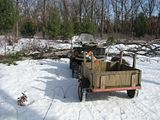
Got one tree all cut up.
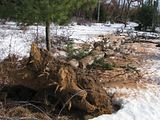
LOOK! An airplane with an actual propeller for a change!

Got it all split up. It made a nice couple piles of wood.

Just for shits and giggles, how about I try to pull the loaded trailer since I had no trouble at all with it empty? What's the worst that could happen? I wouldn't be able to pull it and would have to unload it maybe?
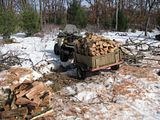
And that's exactly what happened. And that's exactly what I had to do! Ha ha! Oh well, there's a couple nice loads of wood waiting for me when the snow melts. In the meantime I can keep cutting and pile it where I cut it.
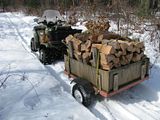
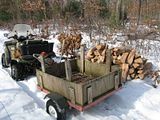
- Quads, hailing from Grand Marsh Observatory atop Elk Castle Hill







- Quads, hailing from Grand Marsh Observatory atop Elk Castle Hill
Shaking on space station rattles NASA
Vigorous vibrations caught on video during orbital reboost last month
A faulty rocket command sequence aboard the international space station caused the 300-ton structure to shake back and forth vigorously for two minutes last month, during what was supposed to be a routine, gentle orbital adjustment. Space experts in Houston and Moscow have spent the last two weeks searching for the cause of the shaking and doing a damage assessment.
The thrashing of the long solar array wings reached a degree "five times greater than allowed," one source told msnbc.com in an e-mail. Another source said the swaying was the "biggest I've ever seen... Outside the certified limits of ISS structure…"
The extent of the damage or structural weakening induced by the shaking is "very much still in work," a third source said in an e-mail. The attach points of the long booms, and the docking interfaces between pressurized modules, are particularly susceptible to accumulated flex-induced fatigue. In the latter case, loss of pressure integrity is a potential consequence.
This source said two "million-dollar questions" had to be answered soon. First, data gathered from accelerometers and stress sensors on the structure must be analyzed to see how bad the overloads were. Second, why were the Russian commands for the automated rocket burn approved without adequate simulation and testing?
source....
Vigorous vibrations caught on video during orbital reboost last month
A faulty rocket command sequence aboard the international space station caused the 300-ton structure to shake back and forth vigorously for two minutes last month, during what was supposed to be a routine, gentle orbital adjustment. Space experts in Houston and Moscow have spent the last two weeks searching for the cause of the shaking and doing a damage assessment.
The thrashing of the long solar array wings reached a degree "five times greater than allowed," one source told msnbc.com in an e-mail. Another source said the swaying was the "biggest I've ever seen... Outside the certified limits of ISS structure…"
The extent of the damage or structural weakening induced by the shaking is "very much still in work," a third source said in an e-mail. The attach points of the long booms, and the docking interfaces between pressurized modules, are particularly susceptible to accumulated flex-induced fatigue. In the latter case, loss of pressure integrity is a potential consequence.
This source said two "million-dollar questions" had to be answered soon. First, data gathered from accelerometers and stress sensors on the structure must be analyzed to see how bad the overloads were. Second, why were the Russian commands for the automated rocket burn approved without adequate simulation and testing?
source....
Two bright orange stars stand high in the south this evening. Aldebaran is at one point of a V-shaped pattern of stars that outlines the face of Taurus, the bull. And Betelgeuse, to its southeast, is at the top left corner of a rectangle that outlines Orion, the hunter.
- Quads, hailing from Grand Marsh Observatory atop Elk Castle Hill
- Quads, hailing from Grand Marsh Observatory atop Elk Castle Hill
Saturday, February 14, 2009
News From The Observatory
For the first time since the beginning of December, I managed to ride around the trails in the woods today. It's as I thought, the snow is icy and crusty enough now that my Hawkeye stays on top mostly. There was a spot on the north side of a thick stand of jack pine that I broke through a little. Still too much snow to pull a loaded trailer though. But, I can get out there and cut firewood now if I want. I'll just pile it where it's split and haul it up later when the rest of the snow is gone.
My Polaris Hawkeye floated on top of the crust.
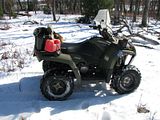
There are several nice firewood trees that tipped over during the winter. I can't wait to split 'em up!
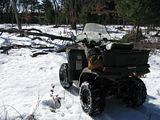
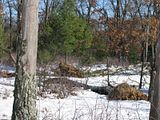
I've never seen water standing on this field before. And yet the pond is low. Go figure.
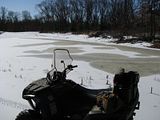
The cows have finally got a place to lay that isn't the same old shit and piss spot where they have been fed their hay bales all winter. And boy is my clothes washer grateful!
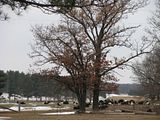
Look Snoopy, a bird!
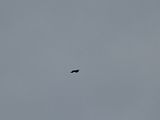
Yep, I see it.

- Quads, hailing from Grand Marsh Observatory atop Elk Castle Hill
For the first time since the beginning of December, I managed to ride around the trails in the woods today. It's as I thought, the snow is icy and crusty enough now that my Hawkeye stays on top mostly. There was a spot on the north side of a thick stand of jack pine that I broke through a little. Still too much snow to pull a loaded trailer though. But, I can get out there and cut firewood now if I want. I'll just pile it where it's split and haul it up later when the rest of the snow is gone.







- Quads, hailing from Grand Marsh Observatory atop Elk Castle Hill
Orion’s Belt
While you’re in the area, sweep across the silver-blue stars of Orion’s belt with binoculars or a finderscope. From east to west, the stars of Orion’s Belt are called Alnitak, Alnilam, and Mintaka. These stars are, respectively, 800, 1300, and 900 light years away, and they are all young massive stars that burn extremely hot. Mintaka has a 7th-magnitude companion about 53″ away, easily visible in binoculars. Alnitak is bathed in nebulosity that includes IC434, the famed Horsehead Nebula. You will not, however, see this nebula visually. Look also for an S-shaped series of stars that starts above Mintaka, and sweeps down and ends between Alnilam and Alnitak.
source....
While you’re in the area, sweep across the silver-blue stars of Orion’s belt with binoculars or a finderscope. From east to west, the stars of Orion’s Belt are called Alnitak, Alnilam, and Mintaka. These stars are, respectively, 800, 1300, and 900 light years away, and they are all young massive stars that burn extremely hot. Mintaka has a 7th-magnitude companion about 53″ away, easily visible in binoculars. Alnitak is bathed in nebulosity that includes IC434, the famed Horsehead Nebula. You will not, however, see this nebula visually. Look also for an S-shaped series of stars that starts above Mintaka, and sweeps down and ends between Alnilam and Alnitak.
source....
Madison - Wisconsin officials are in the planning stages of constructing a major park for motorized recreational vehicles, likely in the southern part of the state.
The Department of Natural Resources said the park might be as large as 1,000 acres and would cost up to $8 million to cover land acquisition and development.
Officials briefed the Natural Resources Board on Wednesday, and afterward, an official said the DNR might need another two years to develop a plan.
The agency has been evaluating the need for a park since at least 2006. Since then, the DNR has looked at other parks in the Midwest and discussed options with groups.
The chief selling point for a new park is the growing popularity of all-terrain vehicles, off-road trucks and off-road motorcycles that need dedicated space.
Dan Schuller, director of state parks, said there are several models Wisconsin could pursue.
The agency could run the park itself, or it could leave management to a nonprofit group. ATV registrations have grown by more than 240%, according to the DNR.
The agency said a daily ticket would cost about $25 or $30. A park would include picnic areas and camping.
Statewide, the DNR said, 1,954 miles of motorized trails have been established for summer use, which is considered small for the number of ATV users in the state.
- Quads, hailing from Grand Marsh Observatory atop Elk Castle Hill
The Department of Natural Resources said the park might be as large as 1,000 acres and would cost up to $8 million to cover land acquisition and development.
Officials briefed the Natural Resources Board on Wednesday, and afterward, an official said the DNR might need another two years to develop a plan.
The agency has been evaluating the need for a park since at least 2006. Since then, the DNR has looked at other parks in the Midwest and discussed options with groups.
The chief selling point for a new park is the growing popularity of all-terrain vehicles, off-road trucks and off-road motorcycles that need dedicated space.
Dan Schuller, director of state parks, said there are several models Wisconsin could pursue.
The agency could run the park itself, or it could leave management to a nonprofit group. ATV registrations have grown by more than 240%, according to the DNR.
The agency said a daily ticket would cost about $25 or $30. A park would include picnic areas and camping.
Statewide, the DNR said, 1,954 miles of motorized trails have been established for summer use, which is considered small for the number of ATV users in the state.
- Quads, hailing from Grand Marsh Observatory atop Elk Castle Hill
Friday, February 13, 2009
News From The Observatory
There's still too much snow in the woods to do any serious firewood cutting. For the most part, I think the Hawkeye would stay on top of it now that it's hard and icy. I don't think the loaded trailer would though. When that breaks through the crust, then I've got a problem. So I will have to wait awhile yet. If I get time this weekend, I'll try to run the Hawkeye around in the woods a bit and see how it goes.
Here's a few pictures from one of our recent walks. Today is one of our favorite themes, "Goldie and Snoopy".
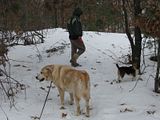
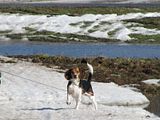
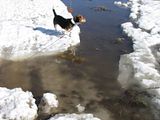
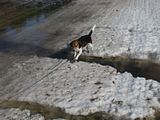
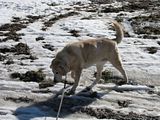
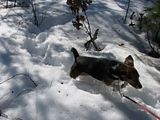
- Quads, hailing from Grand Marsh Observatory atop Elk Castle Hill
There's still too much snow in the woods to do any serious firewood cutting. For the most part, I think the Hawkeye would stay on top of it now that it's hard and icy. I don't think the loaded trailer would though. When that breaks through the crust, then I've got a problem. So I will have to wait awhile yet. If I get time this weekend, I'll try to run the Hawkeye around in the woods a bit and see how it goes.
Here's a few pictures from one of our recent walks. Today is one of our favorite themes, "Goldie and Snoopy".






- Quads, hailing from Grand Marsh Observatory atop Elk Castle Hill
Subscribe to:
Posts (Atom)
